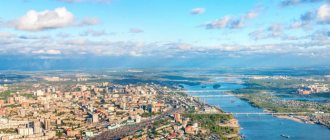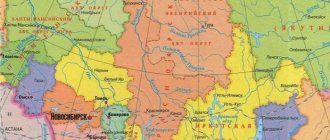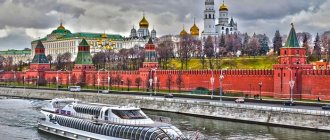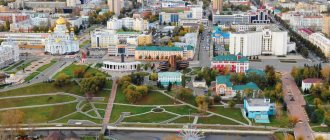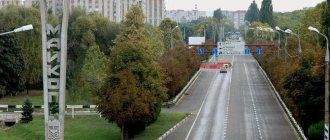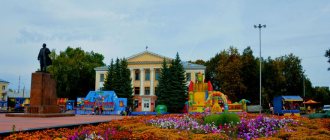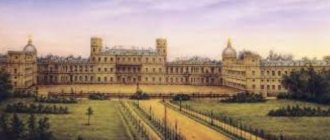Railway stations
At the moment, there are two full-fledged railway stations and one passenger station in Bryansk:
- Train station "Bryansk-Orlovsky" (or Bryansk-I) on Rechnaya street, 2A/4
- Train station "Bryansk-Lgovsky" (Bryansk-II) on Belorusskaya street, 33.
- Station "Ordzhonikidzegrad" in the Bezhitsky district on Vokzalnaya street, 15.
Both stations and the passenger station belong to the Moscow Railway network, connecting 14 constituent entities of the Russian Federation.
Short- and long-distance trains depart from the Bryansk-Orlovsky station throughout Russia and neighboring countries. The geography of destinations is quite extensive. This includes Moscow, Kyiv, Odessa, Klimov, Minsk, Kaliningrad, St. Petersburg, Sochi, Chisinau, Gomel, Brest, Smolensk and many other cities.
The Bryansk-Lgovsky railway station also serves short- and long-distance trains, the geography of directions is almost the same as from the Bryansk-I station. From here you can get direct access to Moscow, Odessa, Khmelnitsky, Gomel, Minsk, Mineralnye Vody, Sochi, Anapa, Lgov and some other cities.
Bryansk-Orlovsky and Bryansk-Lgovsky stations complement each other. If trains run from one station to certain directions several times a week, then from another station (to the same direction) every day.
Although from both stations you can get to almost anywhere in the Bryansk region itself, the Ordzhonikidzegrad station is still used by residents to travel by train to Zhukovka and Roslavl (Smolensk region).
District distribution
Four large districts are what distinguishes Bryansk. Its population is also distributed among these areas. Thus, about 111,654 people live in the Sovetsky district. This is perhaps the most comfortable and comfortable area of the city for living. The industrial Bezhitsa district is considered the most densely populated; about 153,000 citizens live here. Approximately the same number of people live in the Volodarsky and Fokinsky districts - about 70,000.
The population of the districts of Bryansk makes up the overall picture. Of course, it is necessary to take into account the residents of the surrounding areas: the village of Raditsa-Krylovka, Bolshoye Polpino, Belye Berega. About 18,000 residents are concentrated here, but at the moment these settlements are included in various districts of the city.
Bus station in Bryansk
Bryansk central bus station is located on st. Peresveta, 1A, in the very center of the city (detailed description here). Buses from here depart to a large number of cities and towns in the Bryansk region, neighboring regions and border countries.
The main destinations outside the Bryansk region are Voronezh, Moscow, Lipetsk, Kursk, Kirov, Kaluga, Orel, Simferopol, Smolensk and many others. International buses go to Gomel, Mogilev, Donetsk, Warsaw.
Map of Bryansk (Bryansk region). General information about the city
Bryansk is a city in Russia, the administrative center of the Bryansk region.
Bryansk is a major center of mechanical engineering and metalworking in the region, as well as an important border transport hub between Russia, Ukraine and Belarus. The first settlement on the site of the modern city arose in 985, and the city itself was completely destroyed and rebuilt several times during its history. At the end of the 19th century, Bryansk turned into a large industrial and railway junction.
On the online map, Bryansk can be found in Central Russia, on both banks of the Desna River, at the confluence of the Bolva and Snezheti rivers.
Automobile highways
The following highways pass through Bryansk or in the immediate vicinity of the city:
- M3 "Ukraine". The federal highway starts in Moscow, passes through Kaluga and Bryansk, ends at the state border with Ukraine, from where it goes deep into the neighboring state. The M3 highway is the Russian part of the European route E101 (Moscow - Kyiv). Some sections of the road in Russia are toll roads.
- P120. Federal highway connecting Bryansk with Orel in the eastern direction and with Smolensk in the northwestern direction. From Smolensk the road stretches to the state border with Belarus.
- A240 (formerly M13) is a federal highway from Bryansk (starts in the city) to Novozybkov through Pochep and Klintsy. Like the P120, the A240 highway stretches to the border with Belarus.
Special mention should be made of the P120 highway. Using this road from Bryansk you can get to other highways of federal importance. Not counting the A240 and M3, which also connect to the P120, this also includes main roads:
- — a route from Moscow to Smolensk and further to the border with Belarus.
- M2 “Crimea” is a route from Moscow to Belgorod via Tula, Orel and Kursk, then passes through the territory of Ukraine, exits in the north of the Republic of Crimea and stretches to Yalta through Simferopol.
- A130 is a federal highway from Moscow to Roslavl and further to the border with Belarus.
Bryansk on the map of Russia – where it is located. Geography of the city
Bryansk on the map of Russia is located in Central Russia, in the northeastern part of the Bryansk region, on both banks of the Desna River, at the confluence of the Bolva and Snezheti . The approximate distance to the Ukrainian and Belarusian borders is 100 km to the south and west, respectively. The city extends 10 km in the latitudinal direction, and 16 km in the meridian direction.
Distance from Bryansk to major cities by road:
- Moscow – 390 km to the northeast,
- Tula – 310 km to the northeast,
- Oryol – 130 km east,
- Sumy – 310 km to the south,
- Mogilev – 330 km to the west,
- Smolensk - 250 km to the northwest.
The area around Bryansk is forested; pine, birch and aspen forests adjoin the city from the east, south and north.
Bryansk stands on the Central Russian Upland, which is a gently undulating plain with many gullies and ravines. Its average height within the city is 200 meters.
The climate is temperate continental, with cold winters (average January temperature -6 °C) and warm, humid summers (average July temperature +19 °C). Spring and autumn are long and characterized by unstable weather. Extreme heat and severe frosts are rare. The average annual temperature is +6 °C. About 700 mm of precipitation falls annually, the maximum of which occurs in July (87 mm) and the minimum in March (38 mm).
BRYANSK
BRYANSK , city in Russia, adm. the center of the Bryansk region, forms an urban district. Us. 402.7 thousand people (2019; 415.7 thousand people in 2010; 431.5 thousand people in 2002; 452.2 thousand people in 1989; 394.2 thousand people in 1979; 317.5 thousand people in 1970; 207.3 thousand people in 1959). Located in the west part of the Central Russian Upland, on the Desna River, at the confluence of the Bolva and Snezhet rivers. Railway junction to Moscow, Kyiv (Ukraine), Gomel (Belarus), Smolensk, Orel and Vyazma; There are three railway stations in the city (Bryansk-Orlovsky, Bryansk-Lgovsky and Ordzhonikidzegrad). The junction of federal highways Moscow - Kyiv, Bryansk - Novozybkov - Kobrin (Belarus) and Orel - Roslavl - Rudnya. The Druzhba oil pipeline (Samara - Bryansk - Mozyr) and the gas pipelines Dashava (Ukraine) - Moscow, Shebelinka (Ukraine) - Orel - Smolensk (with a branch to Gomel) pass through Bashkortostan. B. consists of 4 separate districts (separated by the Desna, Bolva and Snezhet rivers): Sovetsky (the administrative and historical center of the city), Fokinsky (at the Bryansk-Lgovsky railway station), Volodarsky (at the Bryansk railway station -Orlovsky) and Bezhitsky (until 1956 a separate city; in 1936–43 Ordzhonikidzegrad).
Story
On the territory of modern B. is known for a Paleolithic site, a settlement and settlement of the Early Iron Age, and a settlement of the 1st millennium AD. e., Romny culture, 2 ancient settlements and settlements of ancient Russian. time. Presumably, the city was originally located on the Chashin Kurgan settlement (the conditional date of the city’s foundation is 985; archaeological materials are from the 11th–15th centuries), from where it was moved to the Pokrovskaya Gora settlement (archaeological materials no earlier than the 2nd half of the 12th century). It was first mentioned in the Ipatiev Chronicle as Dobryansk when describing the events of the beginning. 1147. Was part of the Chernigov principality, from the middle. 13th century center of the Bryansk Principality. In 1310 it was devastated by the Mongol-Tatars. In 1356 he was captured by the Lithuanian prince. Olgerd, after 1357 became part of the Grand Duchy of Lithuania. From the end 15th century the name is used B. In 1500 during the Rus.-Litov. Russian is busy with war. troops, according to the Moscow Truce of 1503 it was annexed to the Russian state. Played an important defensive role in the southwest. borders of the country. In 1607, he withstood the siege of the troops of False Dmitry II for more than a month. From the 17th century There was a large Svensk fair near B. The district town of Kyiv (1708–27), Belgorod (1727–78) and Oryol (1778–1920; until 1796 - Oryol governorship) provinces.
Founded in 1783 (nowadays), it was a major supplier of guns for Russia. armies; from 1873 near B. in the village. Bezhitsa operated the Bryansk plant (nowadays). The lines of the Orlovo-Vitebsk (1868), Polesskaya (1887), and Moscow-Kievo-Voronezh (1899) railways passed through Bolshaya. During the First World War of 1914–18, a garrison (about 50 thousand people) was stationed in Byelorussia. B. is the center of the Bryansk province (1920–29), the regional center of the Western (1929–37) and Oryol (1937–44) regions. During the Great Patriotic War, on October 6, 1941, Germany was occupied. troops, heavily destroyed, liberated on September 17, 1943 (in 1945 included in the list of 15 historical cities subject to restoration). Since 1944, the center of the Bryansk region, a major center of mechanical engineering. In 1950, the village entered the boundaries of B. Uritsky, in 1956 - the city of Bezhitsa and the village. Settlement. City of Military Glory (2010).
Architecture
On the high right bank of the Desna there is a historical site. the core of B. with churches on the sites of ancient architecture. dominants: Pokrovskaya (late 17th – early 18th centuries), Vvedenskaya (1702–05), Gorne-Nikolskaya (1751; bell tower, 1st half of the 19th century) and Spaso-Grobovskaya (1904). In the end 17th–18th centuries stone construction was carried out in the forms of Baroque (Church of the Resurrection, 1739–41), Naryshkin Baroque (Church of the Trinity in Bezhichi, 1st half - mid-18th century), early classicism (customs, 2nd half of the 18th century ., is the oldest civil building of B.).
Holy Dormition Svensky Monastery near Bryansk. Gate Sretenskaya Church. 1670–90s Photo by L.C. Maciel-Sanchez
Regular plan 1780 means. adjustments in 1802 and 1808 were carried out during the 19th century: Ch. an axis with three square squares strung on it connects the mountainous part of the city with the coastal one. Among the architects monuments in the style of classicism - the Bryansk Arsenal complex (late 18th–20th centuries), the house of the general director of the Bryansk Arsenal and the barracks of the Dorogobuzh regiment (both - late 18th century; the barracks in their modern form were erected in 1898), c. Nativity of the Virgin Mary (1827–31); buildings in neo-Russian style - mountains. hospital (last quarter of the 19th century), women's gymnasium (1907). In the 1920s large objects were erected in the forms of constructivism: the House of Soviets (1925–26, architect A.Z. Grinberg), the House of Communications (1930–31, architect Grinberg, etc.), etc. Construction and improvement of Bolshoi, with special attention to system of boulevards, parks and public gardens (the green massif "Sudki", the grove "Nightingale" with 300-year-old oak trees, etc.), are being implemented according to the plan of 1968. Monuments: Military and partisan glory (1966, sculptor A. P. Faydysh-Krandievsky, architects M. O. Barshch, A. N. Kolchin), pilot P. M. Kamozin (sculptor M. G. Manizer, architect A. P. Velikanov), 1000th anniversary of Bashkortostan (sculptural group “Peresvet and Boyan” ) and etc.
Near B., in Suponevo, is the Holy Dormition Svensky Monastery for men, founded in the 1280s. Bryansk prince Roman Mikhailovich Stary. The oldest buildings are the Assumption Cathedral [1560–70s; rebuilt in 1712–15, 1749–58, one of the best buildings of the architect. I. F. Michurina with a unique seven-tier iconostasis early. 18th century, among the icons - “Our Lady of Pechersk (Svenskaya)”, 13th century, now in the State Tretyakov Gallery], c. Anthony and Theodosius of the Pechersk (1560–70s; rebuilt in 1681 and 19th centuries) - blown up in 1930. The monastery was closed in 1924, revived in 1992. The gates of the Sretenskaya Church have been preserved. (1670–90s) and Spaso-Preobrazhenskaya Church. (17th century; rebuilt in 1734–42).
Centers of science and culture
An important scientific, educational and cultural center. Research institutes: “Izoterm” (1990; design, development, production and maintenance of equipment for mechanical engineering, metallurgy and railway transport), “NIIPineftegazstroymash” (2002; construction and reconstruction of enterprises of the fuel and energy complex). Among the universities are state universities: technical (history dates back to 1929; current status since 1995), engineering and technology (founded in 1930 as the Forestry Institute; current name and status since 2015), named after. Academician I. G. Petrovsky (founded in 1930 in Novozybkov as a pedagogical institute; since 1976 - in B.; modern name and status since 2001); Institute of Management and Business (non-state; 1999); branches of a number of Moscow universities and institutes. Regional Scientific Universal Library named after. F. I. Tyutcheva (1944).
Museums: state local history museum (1921; includes 13 branches), regional art museum and exhibition center (1968), commander of the partisan detachment D. N. Medvedev (1975), artists brothers S. P. and A. P. Tkachev (1995), folk ethnography and crafts (2001), Literary (with the department “Museum of Kozma Prutkov”); as well as the park-museum of wooden sculptures named after. A.K. Tolstoy (1936) and the memorial complex “Partisan Glade” (1969) with a museum of the history of the partisan movement in the Bryansk region (“Bryansk Forest”, founded in 1983, opened in 1989). Exhibition Hall (2010). Theatres: dramas named after. A.K. Tolstoy (1926), regional puppet show (1972), regional young spectator show (1981), children's and youth "Adults and Children", children's musical "Orpheus". Regional Philharmonic (founded in 1944 as the Concert Bureau; since 1950 Concert and Variety Bureau; modern name and status since 1960); It includes the Druzhba Concert Hall, orchestras: Governor's Symphony (1993; former city chamber), city folk instruments (1996), city brass (2000); academic choir (1995); ensembles: folk music “Vataga” (2004) and “Nadeya” (2009). Palace of Children's and Youth Creativity named after. Yu. A. Gagarin (1925). Planetarium (1977). Circus (1975).
Sport
Dynamo Stadium (built in 1924; 10 thousand seats), where the football team of the same name (founded in 1931), which competes in the FNL (Football National League) championship in the 2020/21 season, plays its matches.
Farm
The basis of the city's economy is the service sector, including administrative, transport and logistics services and trade.
Large industrial center. There are heavy engineering plants: “Bezhitskaya Steel” (1935; frames of bogies for freight cars, automatic couplers for freight and passenger cars, etc.), “Bryansksantechnika” (1975; steel water-heating boilers, modular mobile automated boiler houses, automated water treatment plants for water-heating and steam boilers, water heaters for heating water in hot water supply systems, etc.) and transport engineering: Bryansk mechanical engineering (production of mainline and shunting diesel locomotives, spare parts for railway transport), automobile (1958; wheeled chassis, wheeled tractors of high cross-country ability , spare parts).
Among other engineering (road construction equipment, trailers), diesel (machinery and equipment for the construction and repair of main pipelines; repair of construction machines, diesel engines and hydraulic equipment), Bryanskselmash (grain harvesters, forage harvesters, etc.), military ( 1919, in Bryansk since 1946).
Enterprises producing electronic equipment and instrument making are widely represented: “Thermotron-plant” (1965; equipment for railways, subways, solar power plants, oil and gas complex, etc.), “Silicon EL Group” (1958; 2nd place in the Russian Federation in production of microelectronics products for the Ministry of Defense of the Russian Federation; production of semiconductor devices, integrated circuits and power modules), NPO Elektrontekhnika (1995; means of operational-technological communications, industrial automation, access control system; export to the CIS countries), research and production (1958 ; radio measuring instruments, medical equipment, lamps, including street and LED), Bryansk Electromechanical Plant (1958; equipment for military communications, medical and railway devices).
The food-flavoring industry includes a bakery, a dairy and a meat-packing plant, the agro-industrial holding Tsar-Myaso (production of semi-finished meat products and canned food), the Bryansk City Dairy Plant (children's dairy products), the Ocean fish processing plant (sliced and filleted fish in vacuum packaging, dried, salted and smoked fish, as well as various salads and snacks), the Bryankonfi confectionery factory, the Bezhitsky Food Processing Plant enterprise (flour confectionery products), (1899, modern name and status since 1987; vodka, balms, tinctures, also lemonade; capacity over 1.4 million decalitres of strong alcoholic beverages per year), (production of beer, kvass, mineral water and rye malt).
Production of phosphate fertilizers and adsorbents ("Agricultural-Industrial Enterprise - Phosphates"), paints, varnishes and enamels (Bryansk Paint Plant), cardboard packaging and other cardboard and paper products (Bryansk Paper Factory), woolen fabrics, incl. suits, school uniforms (Bryansk Worsted Factory, 1956), workwear, bed linen and home textiles (Bryansk social and rehabilitation enterprise of the All-Russian Society of the Deaf, 1944), shoes (Stella Plus Shoe Enterprise). Railway enterprises transport (locomotive and car repair depot, etc.).
Death and birth rates
Lately, the city of Bryansk has not been happy with the news. The population is literally dying out, and the mortality rate continues to rise. The main causes of death are cardiovascular diseases, work-related injuries, accidents, and cancer. If we talk about mortality among young people, then most often it is road accidents.
As for the birth rate, it remains at a constant level, which leads to a decrease in the population in the city. The unstable economic situation in the city and the lack of decent income force families to limit themselves to one child; there are quite a few families with two or more children.

